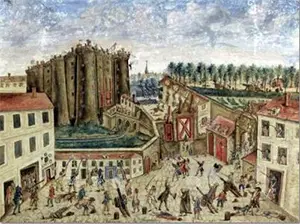The Declaration of Pillnitz
The Declaration of Pillnitz was a statement of support from two European monarchs for another in the shadow of the French Revolution. 
The Revolution had begun with the Storming of the Bastille on July 14, 1789. Revolutionaries took increasingly more threatening measures toward the French king,Louis XVI, and his family. Earning particular enmity from the French middle class and lower class was Louis's wife, Queen Marie Antoinette. The queen's name at birth had been Maria Antonia. She was the daughter of Archduchess Maria Theresa, whose succession to the throne of the Holy Roman Empire had resulted in a war in the 1740s. One of Marie Antoinette's siblings was Leopold II, who had become Holy Roman Emperor on Sept. 30, 1790, when his (and Marie Antoinette's) mother died. As events in France turned more and more violent, Leopold became increasingly concerned for his sister Marie's safety, as did other powerful nobles in Europe. In June 1791, Louis and Marie and their family tried to flee the country. The Flight to Varennes was unsuccessful, and the king and queen were returned to Paris under house arrest. Leopold responded on July 6 by issing the Padua Circular, calling on other European monarchs to join him in demanding that France release their king from custody. 
On August 27 of that same year, Leopold and Prussian King Frederick William II met at Pillnitz Castle, near Dresden, in Saxony. One result of this conference–which ostensibly dealth with joint operations in the east, against Poland and the Ottoman Empire–was the Declaration of Pillnitz, which declared the unified support of the Holy Roman Empire and Prussia for Louis XVI. That support was absolute, in effect a demand that the king be restored to his former monarchy, ideally in absolute form but realistically in constitutional form. The French National Constituent Assembly had been considering that very thing (and had, in effect, ratified the Constituion of 1791), but Louis XVI's attempted escape, even after agreeing to a devolved role as enunciated in that constitution, generated ill will toward the king and ended any hope of a constitutional monarchy with him at the helm. The Declaration of Pillnitz said, in effect, that Prussia and the Empire were willing to go to war in order to reinstate Louis XVI on his throne–with the caveat that such war would not be prosecuted without the acquiescence of other European powers. The appetite for war at that time among other European powers, particularly Great Britain, was not high. French revolutionaries, however, interpreted the Declaration of Pillnitz as a provocation. Angry words came from the leaders of the French revolution. When Leopold II and Frederick William II agreed to a defensive alliance, in February 1792, that was enough for France, which declared war on the Empire on April 20, 1792, beginning the War of the First Coalition. |
|
Social Studies for Kids
copyright 2002–2024
David White




